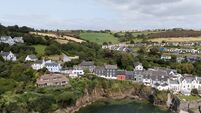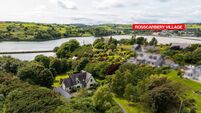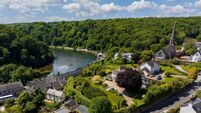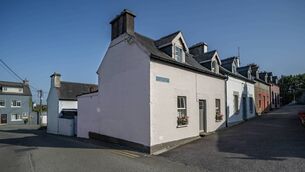A spectacular home designed — and built — by the occupants

The principal building which garnered the RIAI award is also the home and professional workspace for the lead architect Caroilín Liston.
Recently completed on a 1.8 acre rural site in Walshestown, Limerick, this at-ease new build is primarily the family home of Caroilín, her architect husband Eoin O’Grady who’s an associate director with Limerick city practice Healy Partners (that firm won a RIAI award for the city’s Milk Market makeover four years ago) as well as their son Gearóid.
Young Gearóid has free-range access and long, open runs around this most hospitable of contemporary homes, perfect for toddles, runs, chasing and biking. His cousins love to call, and they love the windows that drop right down to ground level, as there’s always something outside to see, birds, rabbits and cows in yonder fields.
Caroilín and Eoin both grew up in nearby townlands, but only met for the first time as practicising architects after studying in Scotland. They each had always envisaged returning to live in rural Limerick.
They’re already pretty rooted to this spot: not only does their home integrate re-used local Kilmeedy sandstone, but Liston Architecture is also making a mark here — Caroilín did a recent upgrade and new entrance for the local Mahoonagh national school.
Building one’s own home is a dream for many: for architects, even more so. This dream took 13 months to deliver, and was done very-much as a hands-on, direct-labour job by the couple — literally, after Kingspan did the initial timber frame construction.
The duo “were greatly assisted by friends and family, lots of them,” Caroilín acknowledges. Several of Eoin’s siblings, for example, have house building experience themselves, operating almost on a co-operative ‘meitheal’ system of mutual assistance.
This one-off is no small building — it’s a very surprising 3,500 sq ft — but one of its real design successes is how it disguises its real floor area, while all the time looking natural, low-slung and vernacular in its setting.
Set in Golden Vale, West Limerick land, the level site is about 1.8 acres, and has recently had beech hedging put down too. It is unusual in that it was built toward the back end of its site, not facing up to the road more commonly seen on rural sites.
When you’re in the house, the eye is also taken by farm activity, something moving in the fields, or tractor cabs glimpsed trucking past the boundary ditches on the public road.
Effectively, it’s two related two-storey and slate-roofed structures, set in an ‘L’ and with a slender, single storey link between the two sections. One block, with east/west aspect is given over to bedrooms, two at ground level, and two more overhead which aren’t yet completed.
Overall design and layout was sensibly dictated in the main by aspect, so the main kitchen/dining space with its extensive glazing faces full south, with west-facing family room at the end, positioned for dramatic sunsets over distant West Limerick hills,and closer to the site’s rear boundary, an old, low oak tree forms a lovely, green orb when in leaf.
This main living block has its services (guest WC, utility/pantry and plant room) to the northern side of the house, where windows are smallest, slender and set between a dry-stone wall sections which frame part of the approach to the wide front door.
Entry is into the wide link corridor between the house’s wings, with a drystone wall also featuring just on the left. This link is single storey and flat roofed, topped with a single-ply membrane, while a light-well above the back wall (facing the entry door) pulls light down in a wash to this space, with main rooms/routes opening off.
Immediately over the threshold, you notice the floor: it’s polished concrete on almost all of the ground level, and it’s a super job. Caroilín and Eoin opted to have skilled finishers Concrete Concepts from Rathkeale grind/polish the floor’s concrete slab: another option is to polish a poured top screed, but this wasn’t necessary in their case, she says.
The same commitment to concrete can be seen in the kitchen. where the units are framed in polished concrete, as are the counters and worksurfaces, and the same continuity of materials appears also on the few ground floor interior sills, in places like the guest loo and utility.
Flooring in polished concrete isn’t really a money-saving move, Caroilín explains: what you might save on not buying alternative materials like tiles or timbers, you end up paying out in increased time and labour costs.
Working hand-in-glove (so to speak) with the concrete floor finish is the house’s underfloor heating, which is powered by a geothermal ground source heat pump set-up, with piping running in a loop from the house to the front gate and back.
It’s always on, working in tandem with heat recovery/mechanical /ventilation system overseen and installed by Ashgrove Renewables, and works a treat with regular, even temperatures and fresh air.
Between heating, and lighting, all energy costs come in the one electric bill, and average €140 a month. There’s no need for solar panels, while glass orientation does maximum solar gain in all of the main spaces.
Windows came from Patrickswell, Limerick firm Duggan Systems, and is triple-glazed in aluminium from German manufacturers Schuco.
Much of the glazing is floor-to-ceiling, forging a continuity from inside to outside, and some panes are very large, almost commercial-building sized. Several rooms have windows on two sides of a corner too, always a smart touch.
The overall effect is airy, open, bright, and constantly engaging — well worth having to clean vast swathes of glass, from rain
spatters to grubby fingers. In this house, the kitchen’s at the eastern end of the living/dining wing, with views back to the road from the sink, and the cooking/prep area is separated from the middle dining section by a low, dividing wall, which has a section rising just above worktop height: it means stuff on the counters can be kept out of view of the dining table — or away from grabbing hands, given Caroilín’s skills at baking.

Kitchen units are unusual; sourced and installed from Limerick man Aidan Quaide, and look like sheets of rich-grained timbers, but in fact they’re done in a sort of vinyl, and are free of any protruding handles also for a slick, unfussed look.
The same joiner made the house’s built-in furniture, while another Ballingarry craft-worker, David O’Hanlon, made the immensely heavy, solid timber dining table, good for eight diners, and a century or two of use. That table’s a freshly made heirloom, and looks right at home with an eclectic selection of chairs and retro furniture, include G-Plan like sideboards, and a fantastic old radio-gramophone.
A low-set, double-sided wood-burning fireplace is set between the dining area and, on the far side of a dividing wall, by a family living room, with an entire gable end wall of glass, half of which slides back for garden/patio access.
The fire (with slide-up glass screens for protection) is rarely if ever needed, but is lit as much for effect as anything and is vented via a stainless steel twin-wall flue up which pokes up through Caroilín’s 500 sq ft architects’ design offices (she’s MRIAI registered and accredited) upstairs, which has Veluxes on both roof pitches, as well as a balcony overlooking the family/living room beneath in a sort of adaptable, over-sized mezzanine arrangement.

Natural light floods the house all day and come evening there’s a mix of commercial quality recessed spotlights and task pendants, including an origami-like Normann Copenhagen white shade over the dining table: it’s called the Norm 69, as it comes in that number of parts, for home assembly.
Over in the sleeping wing, there are two ground floor bedrooms, served by a wet-room shower/WC, and a straight-up stairs leads to two more as-yet unfinished bedrooms, each set for en suites and the master bedroom’s private bathroom get the largest upstairs corner window of all.
In contrast, other upstairs windows front and back of this bedroom’s wing are traditional in size and scale block. The contrast in glazing works very effectively, and from the house’s approach from the road, a lot of privacy is given thanks to the right-angles alignment of the two main blocks, and the way the drystone walls left and right break up the mass, adding visual texture.

There is a detached garage off to the right, part-screened yet visually connected to the main dwelling by a sandstone wall.
Overall effect is of a farmhouse cluster that has evolved — although it’s all down to thoughtful design, detailing and an eye for proportion — the benefits of using professional architects. The pitched roofs are in natural slate which, Caroilín feels, is just appropriate for a house like this, modern, efficient, good to look and immediately ‘at home’ in the Irish countryside.
Building one’s own home is a dream.












